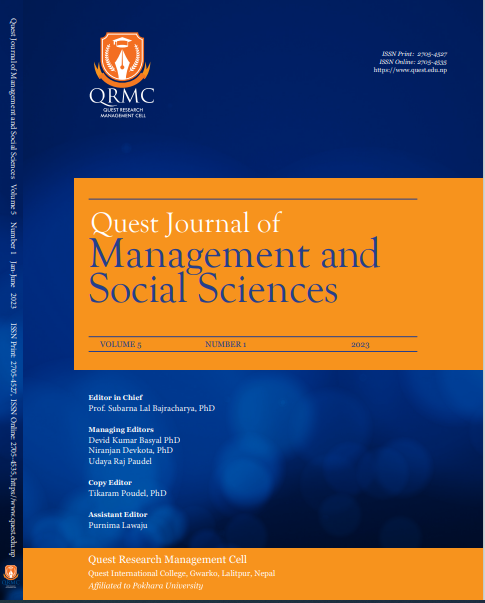Macroeconomics as the Basis of Commercial Banks Stability in Nepal
DOI:
https://doi.org/10.3126/qjmss.v5i1.56291Keywords:
Bank stability, Commercial banks, Macroeconomic variables, ARDL approachAbstract
Background: Maintaining financial stability is vital for all financial institutions, as it fosters public trust and confidence in the entire system contributing to a healthy and well-operating economy in a country. Therefore, banks and other financial institutions must uphold their financial soundness and stability, given their crucial economic role.
Objective: The study examines the influence of macroeconomic factors such as Inflation (INF), Gross Domestic Product (GDP) growth, Inflation Rate (INF), the Exchange rate (ER), Money Supply (M2), and NEPSE Index on bank stability of commercial banks in Nepal.
Method: The study obtained data from the Nepal Rastra Bank, which published a quarterly economic bulletin and database on the Nepalese economy from 2001 to 2022, and applied the Autoregressive Distributed Lag (ARDL) technique for evaluation and interpretation.
Result: The findings from this study indicate that the interest rate and money supply (M2) have a positive and significant impact on bank stability. Similarly, the NEPSE index has a positive but insignificant impact on bank stability. However, bank stability is negatively and statistically significantly impacted by both the exchange and inflation rates.
Conclusion: The primary findings of the research indicate the presence of a sustained and stable association between bank stability and macroeconomic variables. The ARDL techniques analysis demonstrates that GDP growth, inflation, effective exchange rate, and NEPSE index are statistically significant factors, implying that they have a robust capacity to clarify the evolution of bank stability in Nepal.
Implications: Therefore, the study suggests that policymakers and regulators need to pay close attention to macroeconomic indicators such as inflation, interest rates, money supply (M2), and exchange rates to ensure the stability and soundness of the banking system. The research also highlights the need for commercial banks to closely monitor macroeconomic developments and adjust their strategies accordingly to mitigate risks and maintain stability.
Downloads
Downloads
Published
How to Cite
Issue
Section
License
Copyright (c) 2023 Quest Journal of Management and Social Sciences

This work is licensed under a Creative Commons Attribution-NonCommercial-NoDerivatives 4.0 International License.
This license enables reusers to copy and distribute the material in any medium or format in unadapted form only, for noncommercial purposes only, and only so long as attribution is given to the creator.




